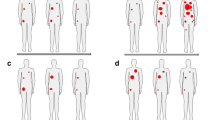Abstract
Introduction
The American Cancer Society estimated 66,120 new cases of non-Hodgkin lymphoma (NHL) in the USA in 2008. Radioimmunotherapy has been shown in clinical trials to be an effective treatment for refractory/relapsed NHL. The available agents are Bexxar®, a 131I radiolabeled murine monoclonal antibody and Zevalin®, a 90Y radiolabeled murine antibody. Both target CD20 receptors present on the surface of lymphocytes. We present our clinical experience with Bexxar® and Zevalin® in the management of low-grade refractory or relapsed NHL.
Methods
This is a retrospective study (Jan 2000–Jul 2006) of 67 patients with NHL, who were treated with Bexxar® (31 patients, group A) or Zevalin® (36 patients, group B) for refractory/relapsed disease. Group A included 16 men and 15 women, 35–81 years old (average, 59.3 ± 13.4). Group B included 27 men and nine women, 36–85 years old (average, 55.4 ± 13.8). Therapeutic doses ranged 40–138 mCi (average, 78.1 ± 28.2) for Bexxar® and 17–34 mCi (average, 28.8 ± 4.37) for Zevalin®.
Results
Objective responses were induced in 22 of the 31 patients (70.9%) in group A and 28 of the 36 patients (77.8%) in group B. Complete response was noted in 11 patients (35.5%), partial response in seven patients (22.6%), and mixed response in four patients (12.9%) in group A. There were five patients (16.1%) with stable disease and four patients (12.9%) with disease progression in the same group. Complete response was noted in 15 patients (41.7%), partial response in nine patients (25%), and mixed response in four patients (11.1%) in group B. There were four patients (11.1%) with stable disease and another four patients (11.1%) with disease progression in the same group. The average decreases at posttherapy nadir were 36.9% ± 0.33 (group A) and 52.6% ± 0.32 (group B) for platelets, 27.8% ± 0.27 (group A) and 34.2% ± 0.38 (group B) for leukocytes, and 4.9% ± 0.15 (group A) and 7.6% ± 0.11 (group B) for hemoglobin. Grades 3 and 4 hematological toxicity occurred in 14 patients (45.2%) treated with Bexxar® and 22 patients (61.1%) treated with Zevalin®, but was reversible.
Conclusion
Our study suggests that clinical practice of Bexxar® and Zevalin® radioimmunotherapy is an effective and safe adjunctive treatment for patients with NHL refractory/relapsed to conventional treatment. However, due to the small number of subjects, it was not possible to determine whether differences in the outcomes or toxicities from the two agents were statistically significant.




Similar content being viewed by others
References
Jemal A, Siegel R, Ward E, Hao Y, Xu J, Murray T et al (2008) Cancer statistics. CA Cancer J Clin 58(2):71–96
Young GA, Iland HJ (2007) Clinical perspectives in lymphoma. Intern Med J 37(7):478–484
Fisher RI, Kaminski MS, Wahl RL, Knox SJ, Zelenetz AD, Vose JM et al (2005) Tositumomab and iodine-131 tositumomab produces durable complete remissions in a subset of heavily pretreated patients with low-grade and transformed non-Hodgkin's lymphomas. J Clin Oncol 23(30):7565–7573
Wiseman GA, Conti PS, Vo K, Schilder RJ, Gordon LI, Emmanouilides C et al (2007) Weight-based dosing of Yttrium 90 ibritumomab tiuxetan in patients with relapsed or refractory B-cell non-Hodgkin lymphoma. Clin Lymphoma Myeloma 7(8):514–517
Knox SJ, Goris ML, Trisler K, Negrin R, Davis T, Liles T-M et al (1996) 90-Y-labeled anti-CD20 monoclonal antibody therapy of recurrent B cell lymphoma. Clin Cancer Res 2(3):457–470
Knox SJ, Goris ML, Wessels BW (1992) Overview of animal studies comparing radioimmunotherapy with dose equivalent external beam irradiation. Radiother Oncol 23(2):111–117
Knox SJ, Levy R, Miller RA, Uhland W, Schiele J, Ruehl W et al (1990) Determinants of the anti-tumor effect of radiolabelled monoclonal antibodies. Cancer Res 50(16):4935–4940
Knox SJ, Sutherland W, Goris ML (1993) Correlation of tumor sensitivity to low dose rate irradiation with G2/M-phase block and other radiobiological parameters. Radiat Res 135(1):24–31
Langmuir VK, Fowler JF, Knox SJ, Wessels BW, Sutherland RM, Wong JY (1993) Radiobiology of radiolabeled antibody therapy as applied to tumor dosimetry. Med Phys 20(2 Pt 2):601–610
Zinzani PL, d'Amore F, Bombardieri E, Brammer C, Codina JG, Illidge T et al (2008) Consensus conference: implementing treatment recommendations on yttrium-90 immunotherapy in clinical practice—report of a European workshop. Eur J Cancer 44(3):366–373
Johnson PW, Rohatiner AZ, Whelan JS, Price CG, Love S, Lim J et al (1995) Patterns of survival in patients with recurrent follicular lymphoma: a 20-year study from a single center. J Clin Oncol 13(1):140–147
Horning SJ, Younes A, Kroll S, Jain V, Lucas J, Podoloff D et al (2005) Efficacy and safety of tositumomab and iodine-131 tositumomab (Bexxar) in B-cell lymphoma progressive after rituximab. J Clin Oncol 23(4):712–719
Kaminski MS, Zelenetz AD, Press OW, Saleh M, Leonard J, Fehrenbacher L et al (2001) Pivotal study of I-131 tositumomab for chemotherapy-refractory low-grade or transformed low-grade B-cell non-Hodgkin's lymphomas. J Clin Oncol 19(19):3918–3928
Kaminski MS, Tuck M, Estes J, Kolstad A, Ross CW, Zasadny K et al (2005) 131I-tositumomab therapy as initial treatment for follicular lymphoma. N Engl J Med 352(5):441–449
Davis TA, Kaminski MS, Leonard JP, Hsu FJ, Wilkinson M, Zelenetz A et al (2004) The radioisotope contributes significantly to the activity of radioimmunotherapy. Clin Cancer Res 10(23):7792–7798
Forero A, Weiden PL, Vose JM, Knox SJ, LoBuglio AF, Hankins J et al (2004) Phase I trial of a novel anti-CD20 fusion protein in pretargeted radioimmunotherapy for B-cell non-Hodgkin’s lymphoma. Blood 104(1):227–236
Jacene HA, Filice R, Kasecamp W, Wahl RL (2007) Comparison of 90Y-ibritumomab tiuxetan and 131I-tositumomab in clinical practice. J Nucl Med 48(11):1767–1776
Author information
Authors and Affiliations
Corresponding author
Rights and permissions
About this article
Cite this article
Iagaru, A., Mittra, E.S., Ganjoo, K. et al. 131I-Tositumomab (Bexxar®) vs.90Y-Ibritumomab (Zevalin®) Therapy of Low-Grade Refractory/Relapsed Non-Hodgkin Lymphoma. Mol Imaging Biol 12, 198–203 (2010). https://doi.org/10.1007/s11307-009-0245-9
Received:
Revised:
Accepted:
Published:
Issue Date:
DOI: https://doi.org/10.1007/s11307-009-0245-9




